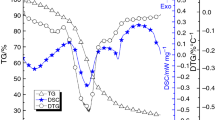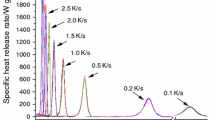Abstract
The thermal properties of EPS foam were tested by simultaneous thermal analysis in a nitrogen environment, using a Netzsch STA 449C TG-DSC. Pyrolysis products were characterized using mass spectrometry and Fourier transform infrared spectroscopy. The flammability of EPS foam was examined using microscale combustion calorimetry. Heat release rate, peak heat release rate, heat release capacity, and some typical temperatures were obtained. The relationships between thermal analysis and MCC were derived from above test results. This could become a significant methodology in establishing the parameters contributing to flammability of polymers.





Similar content being viewed by others
References
The SFPE Handbook of Fire Protection Engineering, Third Edition, ISBN: 087765-451-4.
Lindholm Johan, Brink Anders, Hupa Mikko. Influence of decreased sample size on cone calorimeter results. Fire Mater. 2012;36:63–73.
Standard test method for determining flammability characteristics of plastics and other solid materials using microscale combustion calorimetry, ASTM 7309–07. American Society for Testing and Materials (International), West Conshohocken, PA (1 April 2007).
Richard E. Lyon and Richard Walters. A Microscale Combustion Calorimeter. DOT/FAA/AR-01/117. Feb 2002.
Thomas S. Lin, Jeffrey M. Cogen, Richard E. Lyon. Correlations between Microscale Combustion Calorimetry and Conventional Flammability Tests for Flame Retardant Wire and Cable Compounds, Proceedings of the 56th International Wire & Cable Symposium, 2007.
Yang CQ, He Q. Textile heat release properties measured by microscale combustion calorimetry: experimental repeatability. Fire Mater. 2012;36:127–37.
Chen LJ, Tai QL, Song L, Xing WY, Jie GX, Hu Y. Thermal properties and flame retardancy of an ether-type UV-cured polyurethane coating. eXPRESS Polym Lett. 2010;4(9):539–50.
Yang CQ, He Q. Applications of micro-scale combustion calorimetry to the studies of cotton and nylon fabrics treated with organophosphorus flame retardants. J Anal Appl Pyrol. 2011;91:125–33.
Shuang Hu, Song Lei, Pan Haifeng, Yuan Hu. Effect of a novel chitosan-based flame retardant on thermal and flammability properties of polyvinyl alcohol. J Therm Anal Calorim. 2013;112(2):859–64.
Howell BA, Dumitrascu A. Thermal and combustion characteristics of phosphorus and phosphorus/nitrogen-containing styrene monomers and oligomers. J Therm Anal Calorim. 2012;109(3):1133–7.
Expandable Polystyrene Storage and Handling Safety Guide. NOVA Chemicals Corporation. 2005.
Benrashid Ramazan, Nelson GordonL, Ferm DonaldJ. Effect of Triaryl Phosphate, Zinc and Zinc Borate on Fire Properties of High Impact Polystyrene and High Impact Polystyrene-Polyphenylene Oxide Blend (Modified-Polyphenylene Oxide). J Fire Sci. 1994;12:529–50.
Xie Qiyuan, Zhang Heping, Ye Ruibo. Experimental study on melting and flowing behavior of thermoplastics combustion based on a new setup with a T-shape trough. J Hazard Mater. 2009;166:1321–5.
Zhang Ying, Huang Xinjie, Wang Qingsong, Ji Jie, Sun Jinhua, Yin Yi. Experimental study on the characteristics of horizontal flame spread over XPS surface on plateau. J Hazard Mater. 2011;189:34–9.
Griffin GJ, Bicknell AD, Bradbury GP, White N. Effect of construction method on the fire behavior of sandwich panels with expanded polystyrene cores in room fire tests. J Fire Sci. 2006;24:275–94.
Qiang Xu, Cong Jin, Greg Griffin, Yong Jiang. Fire safety evaluation of expanded polystyrene foam by multi-scale methods. J Therm Anal Calorim. doi: 10.1007/s10973-013-3431-6.
Azimi HamidReza, Rezaei Mostafa, Abbasi Farhang. Thermo-oxidative degradation of MMA–St copolymer and EPS lost foams: kinetics study. Thermochim Acta. 2009;488:43–8.
Kannan Pravin, Biernacki JosephJ, Visco DonaldP Jr, Lambert William. Kinetics of thermal decomposition of expandable polystyrene in different gaseous environments. J Anal Appl Pyrol. 2009;84:139–44.
Dauengauer SA, Utkina OG, Popova GS, Sazanov YuN. Investigation of thermal degradation of polystyrene with the aid of thermal analysis. J Therm Anal Calorim. 1987;32:311–4.
Acknowledgements
This research is supported by the Natural Science Fund of China, Nos. 51076065 and 51376093, and the Open Funding from the State Key Laboratory of Fire Science in China, No. HZ2012-KF05. The facilities established by Qing Lan Project of Jiangsu Province Education Department were used in this research.
Author information
Authors and Affiliations
Corresponding author
Rights and permissions
About this article
Cite this article
Xu, Q., Jin, C. & Jiang, Y. Analysis of the relationship between MCC and thermal analysis results in evaluating flammability of EPS foam. J Therm Anal Calorim 118, 687–693 (2014). https://doi.org/10.1007/s10973-014-3736-0
Received:
Accepted:
Published:
Issue Date:
DOI: https://doi.org/10.1007/s10973-014-3736-0




